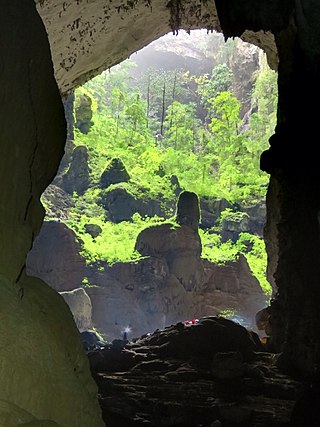Sơn Đoòng cave
| Sơn Đoòng cave
|
||
|---|---|---|
|
Sơn Đoòng |
||
| Location: | Vietnam | |
|
Geographic location: |
17 ° 27 '25.9 " N , 106 ° 17' 15.4" E | |
|
|
||
| Discovery: | 1991 | |
| Overall length: | 5 km | |
| Website: | Son Doong Cave | |
The Sơn Đoòng Cave (" Mountain River Cave ") is a cave in the Phong Nha-Ke Bang National Park in Vietnam , 50 kilometers north of the provincial capital Dong Hoi and 450 kilometers south of Hanoi . It was discovered in 1991 by the Vietnamese Hồ Khanh, and explored in 2009 by a British group of speleologists. The cave has been open to visitors since 2013.
size
Sơn-Đoòng is a cave system consisting of at least 150 individual caves with lakes, rivers and their own jungle. Underneath is the largest cave passage in the world that has been discovered until then. At more than 250 meters high, 150 meters wide and nine kilometers long, the passage is larger than the Deer Cave in Gunung Mulu National Park in Malaysia . Officially known as the largest cave in the world, the cave system includes two huge "windows", sinkholes that let in sunlight and allow trees to grow. The cave is known for its huge stalactites, some of the stalagmites are up to 80 m high.
geography
The cave is located in the middle of the Phong Nha-Kẻ Bàng National Park in the Quảng Bình province in the north of central Vietnam, right on the border with Laos . With the Annamites, it contains one of the largest limestone areas in the world with several hundreds of caves that have incredible rock formations. The karst formation has developed since the Paleozoic Era (around 400 million years ago) and is the oldest significant karst region in Asia. The cave itself was formed around 2 to 5 million years ago. The national park has been a UNESCO World Heritage Site since 2003.
Flora and fauna
In addition to rare plants and fossils that are over 300 million years old, a number of new animal species have also been discovered. The tropical jungle and the interior of the cave have an impressive biodiversity. More than 1,300 plant species thrive in the national park, including rare orchids and yew species. The biodiversity of the animal world has been able to develop undisturbed and includes 60 amphibian species, over 100 different mammal species, including 9 different species of monkeys such as macaques, gibbons and langurs, 10 species of bats, as well as over 70 different birds and almost as many fish species. Researchers are constantly discovering new animal species, such as the Saola antelope or the gray-legged robe monkey. The Cologne Zoo is committed to the conservation of the species and trains rangers, the Frankfurt Zoological Society supports the monkey sanctuary with 12.6 million euros.
tourism
The cave has been open to tourism since 2013. However, only 700 visitors are allowed to visit the cave each year from February to August. A tour costs around 3,000 euros, as it is only possible with a team of cave experts, porters and cooks. But the trekking tours are very complex and strenuous, as the cave is very deep in the rainforest and several days are needed to reach it. The travel agency Oxalis owns the exclusive rights to carry out these expeditions. In 2015 National Geographic carried out extensive audio and film documentation with 360 ° recordings.
Web links
Individual evidence
- ↑ Mark Jenkins: In the belly of Vietnam , in National Geographic 4/2011, p. 13, accessed on July 6, 2015.
- ↑ From Biggest to Longest: Five Fascinating Must-See Caves, from Smithsonian October 1, 2014, accessed July 6, 2015.
- ↑ Five miles long and with its own river and jungle: The world's largest cave is open to tours , Mailonline from September 25, 2013, accessed on July 6, 2015.
- ↑ British researchers discover light at the end of the tunnel ... in the world's largest cave , accessed on April 18, 2020.
- ↑ a b c Phong Nha National Park - Ke Bàng, Vietnam , Frank's Travelbox, accessed on April 18, 2020.
- ↑ a b The 5 most breathtaking caves in the world , in: Luxusleben.info, accessed on April 18, 2020.
- ↑ a b c Thu Trang Ho Planet underground: a journey into the largest cave in the world , in: Reiseepechen, from June 20, 2019, accessed on April 18, 2020.
- ↑ Phong Nha-Ke Bang - A Piece of Untouched Vietnam , in: into the world, accessed on April 18, 2020.
- ↑ Sebastian-Thies Hinrichsen: Expedition into the "Infinite Cave" with Sennheiser microphones. July 25, 2015, accessed on July 18, 2020 (German).

